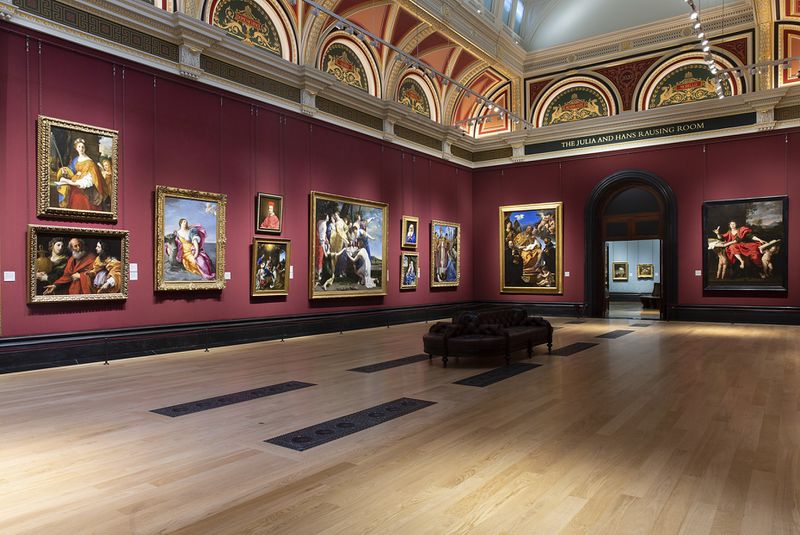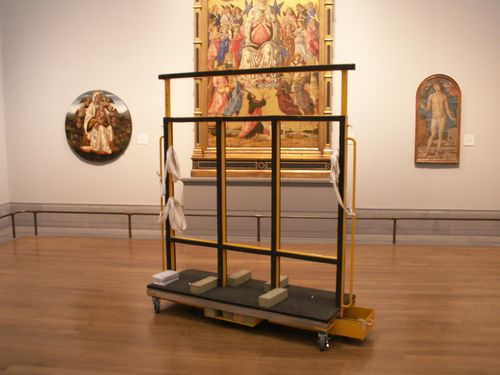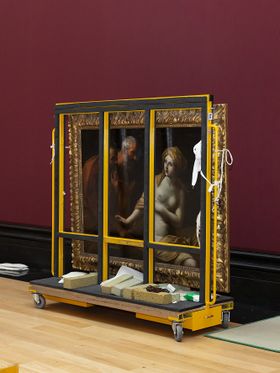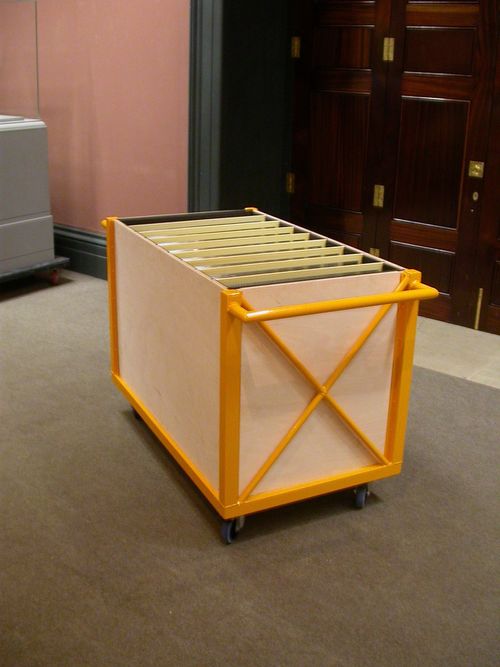The Collection
This section describes the colour category system. This followed by description of each category including equipment associated with it and how to use it. Then complicated/bespoke examples (NG6337 etc) and finally how to prepare the collection for loan. This will include all the casing stuff plus a description of the relationship with KSL.
Introduction

The National Gallery’s collection of art consists mainly of western European paintings from the 13th century to the beginning of the 20th century. The collection does include some sculptural objects, but the painting collection is its primary focus. Within this area of paintings are a wide variety of works with differing physical characteristics. These vary from early renaissance frescoes and panels (on a range of wooden supports) to many works on canvas and works on paper.
These works vary enormously in terms of mass and durability. For example, the collection includes very large and complex altarpieces, constructed from large wooden sections that can weigh up to 500kgs, to works on paper such as the Leonardo cartoon which are extremely ephemeral and require specific handling and display solutions. Paradoxically, large works of significant mass are themselves extremely vulnerable to movement by virtue of their structure working against the material they are made of when they are manipulated.
The role of the art handling department is to create safe systems of operations that we can use when moving the collection for any purpose. Any system that we develop needs to be understood by the art handling team as well as being reliable and repeatable. It also needs to follow the best conservation practice as described to us by our conservation team at the gallery.
The need for repeatable systems is due to the volume of moves that are undertaken each year with the collection. On average, around 15,000 moves of art works occur within the site of The National Gallery each year, all undertaken by the art handling team. This covers all aspects of our work, including basic moves throughout the gallery site, thousands of separate installations and preparation of works from the collection when loaned to other museums throughout the world.
Our aim is to create working systems that can safely cope with this volume of work whilst also being measurable. This is very important for the standard of our work as though we do create individual solutions to specific problems, we also need to know that our team is operating within a well understood framework from which we can confidently make decisions about the work in our care.
To facilitate our approach to the collection, we have developed a technical classification system that describes the art handling requirements for each individual object within the collection. This system breaks the collection down into three categories and names each category after a colour, either yellow, blue or silver.
Each of the categories assumes some simple characteristics for each object. Essentially weight and size are the main determining factors, the record of which category a work is placed in can be found on the individual record for each artwork held in the main collection database (TMS) under the art handling section. Within this record further, more detailed information can be included (please refer to the database description for further information).
The use of a largely generic classification system then allows us to design specific handling solutions to each category. In turn, the problems of handling and installing a specific object can be seen within this framework. The nature of the collection at the gallery has meant that such an approach is possible since the movement of large numbers of works that have similar physical characteristics is essentially the same. It also means that specific, individual solutions can be found to unique problems that can be seen within the context of the main framework.
A crucial element to the system is to develop the correct equipment alongside the correct process and approach. The art handling department has a long-standing equipment development program (now more than 20 years old) that designs and has manufactured specific equipment relevant to each of the categories.
It is worth noting that we apply the same or similar approach to our exhibitions where possible, however the requirements of lenders and the type of objects that may be included in our shows means that a more variable response is often necessary (please refer to exhibitions). This though can still be referred to the general principals established by our system. In the following pages we describe the processes and equipment for each of the categories.
Colour Category System
Due to the nature of the picture collection at The National Gallery, it is possible to categorise paintings according to the actions necessary for de/installation. This has led us to group works into three categories for this purpose, which are as follows:
Standard Manual Lift or Yellow Move
The yellow move category encompasses the simplest moves we are required to undertake. The category includes all works that can be manually handled over small distances by two art handlers, or can be installed without the need for additional equipment to elevate the painting into position.
The category does not necessarily state the characteristics of the works it includes but generally it refers to paintings weighing under 60kgs. The size of the work is also not such a significant factor as quite large paintings can be included if it is determined they fall within the ease of handling required.
The yellow category contains around 60% of the works within the gallery's collection and will form the majority of moves throughout the year. Using the correct equipment associated with the category (as listed below) multiple moves of paintings can occur simultaneously and this is frequently found to be the case when large gallery hangs occur. Commonly the works within the category are installed using a plate system or The National Gallery gadget system (please refer to installation methods) and additional security measures are also applied at installation.
Medium Lift or Silver Move
The silver move category covers most of the mid-range installations and moves that we undertake. This category probably accounts for around 20 to 25% of all moves that occur and requires the use of a minimum of three art handlers plus the designated equipment (as described here).
For these moves, we set a limit of 150kgs in weight for the object being moved. Most of the works that fall into this category also tend to be large in area with a major dimension usually exceeding 2 metres.
Heavy Lift or Blue Move
The blue move category encompasses the largest and most logistically challenging objects within the National Gallery’s collection.
The most common example of works found in this category are the group of large altarpieces dating from the early renaissance section of the main collection. These works are usually the heaviest pieces, being up to 500kgs in weight but are also very large objects in surface area with a complex construction.
Although there are exceptions to these categories, nearly every object in the collection can be group in one of these sections. Our approach to designing installation and transportation solutions is informed by this system.
Equipment
Yellow Equipment
As the works associated with this category can be manually handled within the short distances of a gallery or packing room, the equipment required consists of two forms of transportation necessary to move these paintings across larger distances within the two main buildings that make up the National Gallery.
The first and most common piece of equipment used for this purpose is the NG standard Picture Trolley. The standard picture trolley is a medium sized transportation trolley that is used for a large variety of moves and also for temporary storage in the Gallery’s stores. The original design was created by the department more than 20 years ago and consists of 4 units. The design, though generic in nature, was conceived to allow the best ease of movement throughout the Gallery site whilst also maximising the carrying capacity of the trolley. Its durability is such that it can also be used to carry works outside of the yellow category.
Part of the working philosophy of the team is that our art handlers carry only a very minimal amount of equipment on their person (basically a tape measure and standard screwdriver). The yellow trolleys have therefore been designed with a storage capacity for other tools and hanging equipment. This consists of two draws which are located at either end of the trolley.
The yellow trolleys are a standard, daily use piece of equipment which have served us well for many years. However, in keeping with our habit of revising our equipment and improving where necessary, a new design has been developed by one of our team supervisors with the first production model recently delivered. Here is his description of the new design and how it differs from the original model.


Yellow Trollies
The yellow trollies are key to how our teams operate in the gallery and the opportunity to re-think the design was not only a chance to make some physical modifications but also an opportunity to reconsider how we use them and make positive changes to our working practice. The trollies are used for the majority of picture movements, rehangs and exhibitions so the primary aims of my design were to increase the capacity for carrying multiple works, improve access throughout the gallery and to provide teams with the correct tools and fixings for each job.
The original design was very successful and the physical changes I made were relatively minor. I added a horizontal extension allowing us to transport larger paintings, slimmed the overall width of the trolley by 50mm to make it easier to pass through doorways, gave it radial corners to remove the sharp edges and increased the clearance around the wheels allowing us to fit brakes. The trolley itself is made from aluminium rather than the original steel design with a 3mm steel deck replacing the 18mm ply and weighting the bottom to ensure stability and provide the necessary weight for the vibration dampening function of the wheels. For the overall structure I reduced the distance between the two outer uprights which both increases the ability to stack paintings side by side but also increases the central space on the deck for items that need to travel flat.
Working across a large site such as the National Gallery one key issue is ensuring that teams have the right tools and hardware ready to hand for each job. We try to minimise the equipment carried by individual technicians and so the majority of our fixings, screws and tooling are kept in the two drawers of each yellow trolley. Maintaining stock and making sure everything goes back in the right place can be difficult during busy periods and a regular frustration for our teams is tracking back and forth across the gallery in search of missing items. For the new trolley I have designed a removable insert for the fixings drawer. The intention is to provide two inserts for each trolley with fixings specific to the two different hanging systems we work with; either hanging from chains or screwing fixings directly into the wall. Through the act of collecting the right drawer insert for each job I am hoping that the process of acknowledging the contents and stock before setting off will become automatic, thereby reducing the frustration of finding items missing. The inserts also double as a tool box that can be removed for easy access during installs and to be restocked at the end of each day.
Alongside the project of designing the trolley we also repurposed a small existing storage area to function as a tooling station and essentially a garage for the trolleys to be stored in. This area has become key to the function of the new trolley design and intended usage, it puts all of the stock, tooling and resources in one place and the layout is arranged specifically around ease of access with a work bench for storing and stocking the drawer inserts. Providing a space for the trolleys to be returned to at the end of each day and collected from every morning may seem incredibly simple but working across such a large site with multiple picture stores and two tooling areas represents a subtle but fundamental change to how we think about the trolleys and how we use them on a daily basis
Team Supervisor
Picture Bin
The second type of transportation equipment used for yellow moves is the picture bin. The concept for this consists of any kind of box on wheels able to carry small works by placing dividers between each work to allow “bridging”. The department has designed a standard National Gallery picture bin and has two units available to it. However, it is possible to quickly and easily produced this equipment, constructed from MDF or wood and ply and have at least another 10 units made in this way that were produced during temporary periods of very high picture movements (for example emptying stores). The bins are also very useful as temporary storage units where small works can be safely held and accounted for within a proper storage facility.
Unlike the yellow trolleys, there is obviously a physical limit to the size of the works that can be held within a bin. Normally this tends to be paintings with a major frame dimension of no more than 75cms, the works will also be required to weigh less than 25kgs each.
